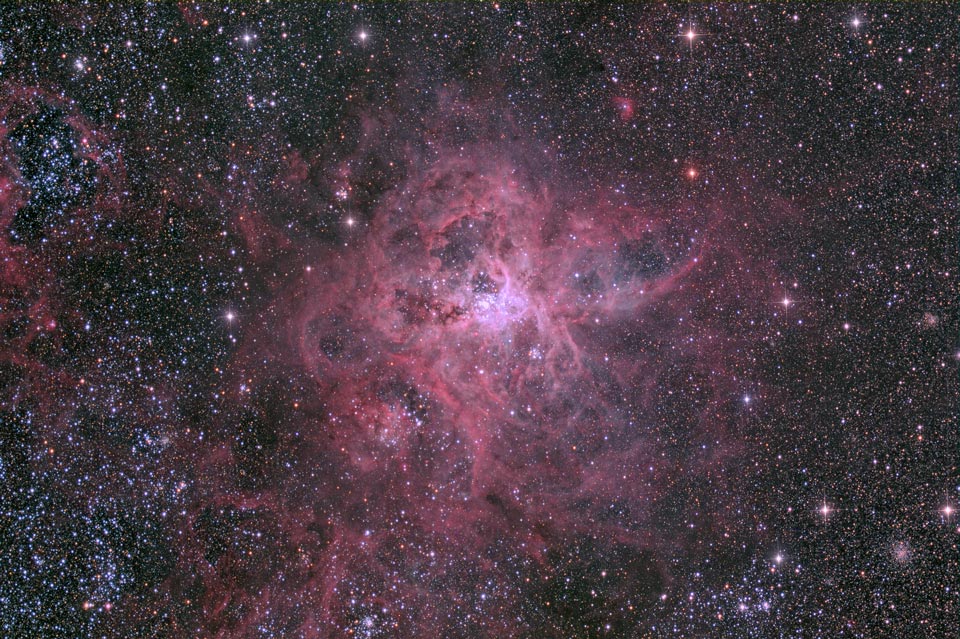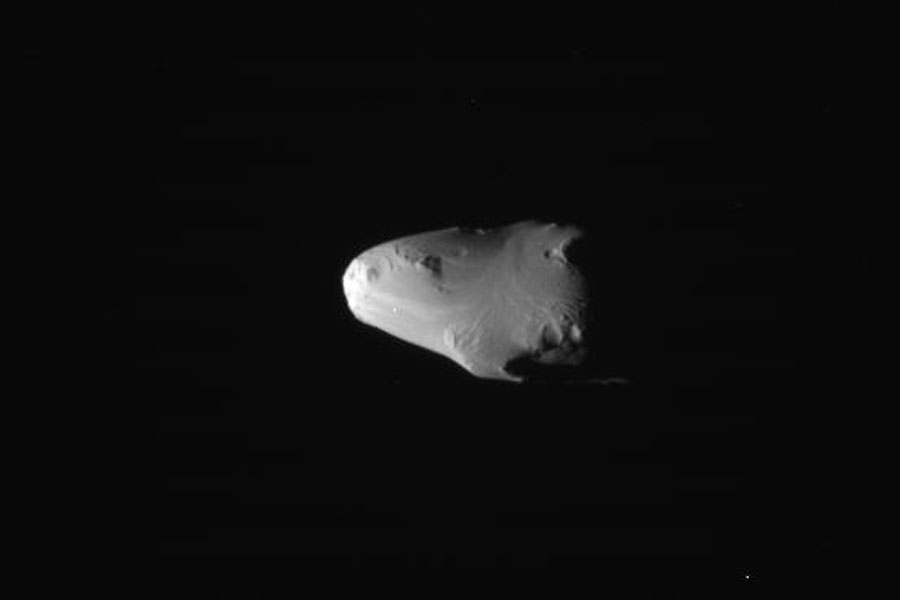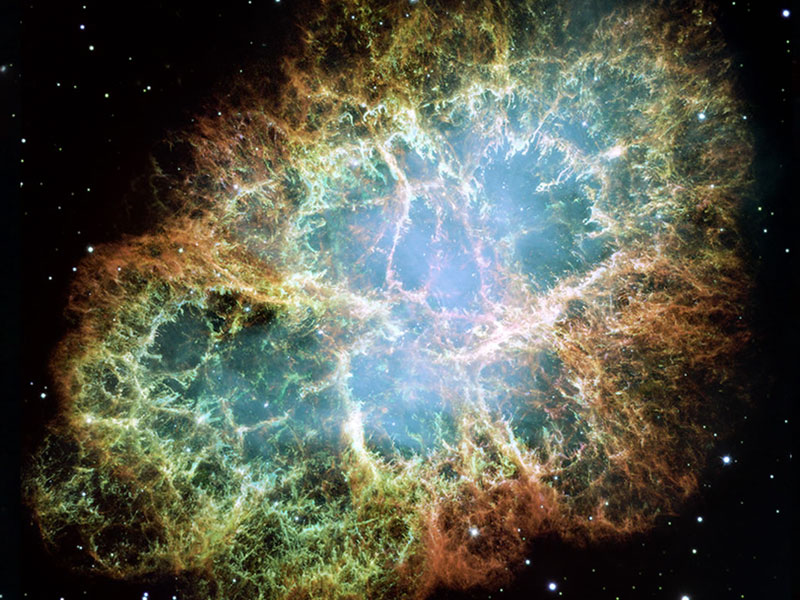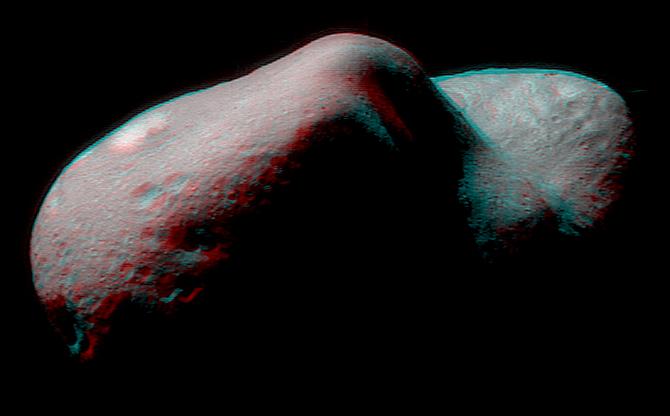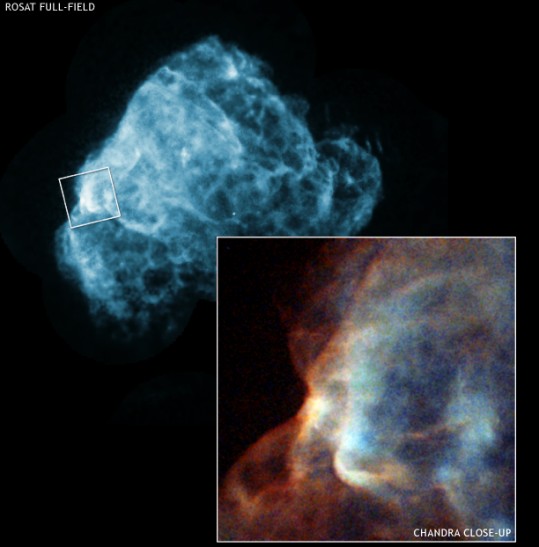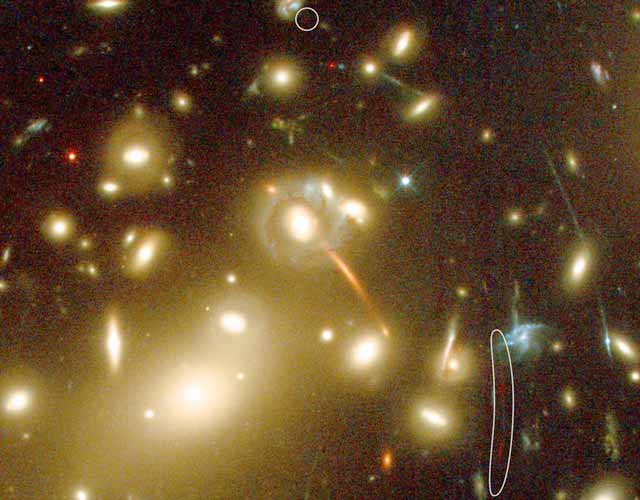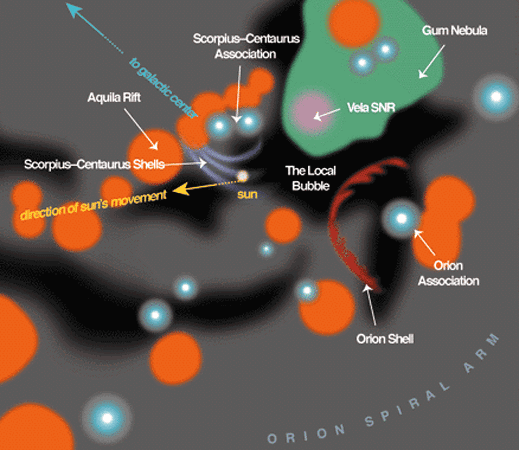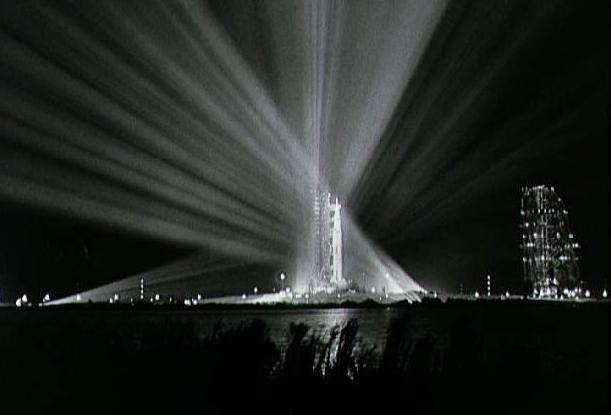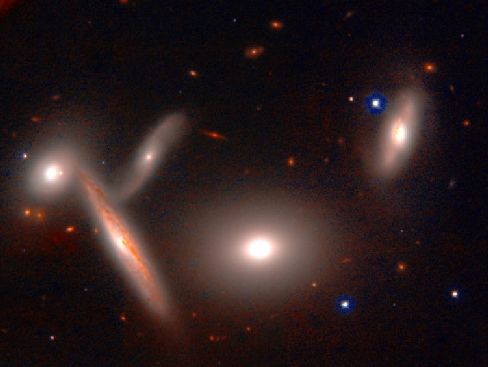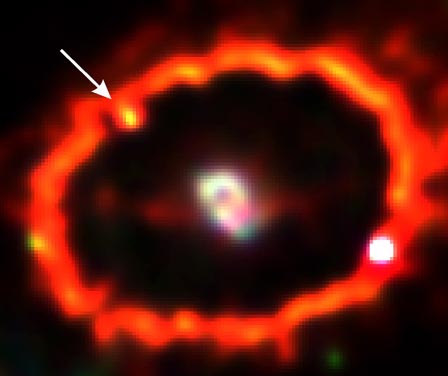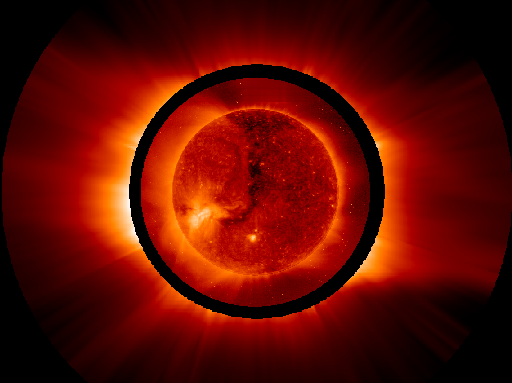| << Previous | Index | Next >> |
2015 When does the Sun look like a flower? In a specific color of red light emitted by hydrogen, as featured here, some regions of the solar chromosphere may resemble a rose. The color-inverted image was taken in 2014 October and shows active solar region 2177. The petals dominating the frame are actually magnetically confined tubes of hot plasma called fibrils, some of which extend longer the diameter of the Earth. In the central region many of these fibrils are seen end-on, while the surrounding regions are typically populated with curved fibrils. When seen over the Sun's edge, these huge plasma tubes are called spicules, and when they occur in passive regions they are termed mottles. Sunspot region 2177 survived for several more days before the complex and tumultuous magnetic field poking through the Sun's surface evolved yet again.
2014 It is the largest and most complex star forming region in the entire galactic neighborhood. Located in the Large Magellanic Cloud, a small satellite galaxy orbiting our Milky Way galaxy, the region's spidery appearance is responsible for its popular name, the Tarantula nebula. This tarantula, however, is about 1,000 light-years across. Were it placed at the distance of Milky Way's Orion Nebula, only 1,500 light-years distant and the nearest stellar nursery to Earth, it would appear to cover about 30 degrees (60 full moons) on the sky. Intriguing details of the nebula are visible in the above image shown in near true colors. The spindly arms of the Tarantula nebula surround NGC 2070, a star cluster that contains some of the brightest, most massive stars known, visible in blue in the image center. Since massive stars live fast and die young, it is not so surprising that the cosmic Tarantula also lies near the site of a close recent supernova.
2013
Video Credit & Copyright: Daniel López (El Cielo de Canarias)
2012 Aristarchus Plateau is anchored in the vast lava flows of the Moon's Oceanus Procellarum. At the plateau's southeastern edge lies the spectacular Aristarchus Crater, an impact crater 40 kilometers wide and 3 kilometers deep. Scan along this remarkable panorama and you will find yourself gazing directly at the crater's west wall for some 25 kilometers. Features along the terraced wall include dark impact melt and debris deposits, bright excavated material, and boulders over 100 meters wide. At a full resolution of 1.6 meters per pixel, the sharp mosaic was created from images recorded by the Lunar Reconnaissance Orbiter's narrow angle camera in November of 2011. The orbiter's vantage point was 70 kilometers east of the crater's center and only 26 kilometers above the lunar surface.
2011 On Valentine's Day (ET) the Sun unleashed one of its most powerful explosions, an X-class flare. The blast was the largest so far in the new solar cycle. Erupting from active region AR1158 in the Sun's southern hemisphere, the flare is captured here in this extreme ultraviolet image from the Solar Dynamics Observatory (SDO). The intense burst of electromagnetic radiation momentarily overwhelmed pixels in SDO's detectors causing the bright vertical blemish. This X-class flare was also accompanied by a coronal mass ejection (CME), a massive cloud of charged particles traveling outward at nearly 900 kilometers per second. Skywatchers at high latitudes should be alert for aurorae tonight.
2010 Why is this moon of Saturn so smooth? This past weekend, humanity's Saturn-orbiting Cassini spacecraft passed as close to Saturn's small moon Calypso as it ever has, and imaged the small moon in unprecedented detail. Pictured above is an early return, raw, unprocessed image of the 20-km long irregularly shaped moon. Like its sister moon Telesto and the shepherd moon Pandora, Calypso has shown itself to be unusually smooth, much smoother than most of Saturn's larger moons. A leading hypothesis for Calypso's smoothness is that much of the moon's surface is actually a relatively loose jumble of rubble -- making Calypso a rubble-pile moon. The loose nature of the small ice pieces allows them to fill in many small craters and other surface features. Calypso orbits Saturn always behind Saturn's much larger moon Tethys, whereas Telesto's orbit always precedes Tethys. Calypso's extremely white surface -- not unlike fresh snow -- may result from the continuous accumulation of fresh ice particles falling in from Saturn's E ring.
2009 What in heaven's blazes is that? When landing in Minneapolis, Minnesota, USA in 2002, just before his flight ascended above cloud level in the early evening, passenger Tyler Blessing saw and photographed "huge curved sheets of glowing light extending from cloud to ground." The glow appeared unlike other unusual lights more typically seen, including crepuscular rays, anticrepuscular rays and the glory. A leading possibility, mentioned initially by the photographer, is that the light sheets are setting sunlight scattered off of falling rain. Alternatively, the phenomenon could just be a peculiar window reflection. APOD readers, who have previously shown an impressive ability to pool their collective intelligence to create a better understanding of photographed sky anomalies, are invited to discuss this online. It might help to know that EXIF data indicates that the image was captured on 2002 September 23 at about 8:07 pm in the evening (local time), and that the camera was reported to be pointing north of west at that time. The oval on the ground, visible in the lower right of the above image, is Canterbury Downs race track.
2008 This is the mess that is left when a star explodes. The Crab Nebula, the result of a supernova seen in 1054 AD, is filled with mysterious filaments. The filaments are not only tremendously complex, but appear to have less mass than expelled in the original supernova and a higher speed than expected from a free explosion. The above image, taken by the Hubble Space Telescope, is presented in three colors chosen for scientific interest. The Crab Nebula spans about 10 light-years. In the nebula's very center lies a pulsar: a neutron star as massive as the Sun but with only the size of a small town. The Crab Pulsar rotates about 30 times each second.
2007 Get out your red/blue glasses and float next to asteroid 433 Eros, now over 220 million kilometers away! Orbiting the Sun once every 1.8 earth-years, asteroid Eros is a diminutive 40 x 14 x 14 kilometer world of undulating horizons, craters, boulders and valleys. Its unsettling scale and bizarre shape are emphasized in this picture - a mosaic of images from the NEAR Shoemaker spacecraft processed to yield a stereo anaglyphic view. Along with dramatic chiaroscuro, NEAR's 3-D imaging provided important measurements of the asteroid's landforms and structures, and clues to the origin of this city-sized chunk of solar system. The smallest features visible here are about 30 meters across. After spending a year in orbit around Eros, the historic Near Shoemaker spacecraft made the first ever landing on an asteroid's surface February 12, 2001.
2006 A massive star ends life as a supernova, blasting its outer layers back to interstellar space. The spectacular death explosion is initiated by the collapse of what has become an impossibly dense stellar core. Pictured is the expanding supernova remnant Puppis A - one of the brightest sources in the x-ray sky. Now seen to be about 10 light-years in diameter, light from the initial stellar explosion first reached Earth a few thousand years ago. Recorded by the Chandra Observatory's x-ray cameras, the inset view shows striking details of the strong shock wave disrupting an interstellar cloud as the shock sweeps through preexisting material. The larger field ROSAT image also captures a pinpoint source of x-rays near the remnant's center. The source is a young neutron star, the remnant of the collapsed stellar core kicked out by the explosion and moving away at about 1,000 kilometers per second.
2005 First imaged by the Mariner 9 spacecraft, Valles Marineris, the grand canyon of Mars, is a system of enormous depressions or chasmas that stretch some 4,000 kilometers along the Martian equator. Looking north over the canyon's central regions, dark Melas Chasma lies in the foreground of this spectacular perspective view. Behind it are Candor Chasma and the steep walls of Ophir Chasma near the horizon. Faulting, surface collapse and landslides are seen to be part of the complex geologic history of these dramatic features, with layered deposits also found within the canyon system. Recorded in 2004, the image represents data from the High Resolution Stereo Camera (HRSC) on board ESA's Mars Express spacecraft. Melas, Candor and Ophir are about 200 kilometers wide and 5 to 7 kilometers deep.
2004 Gravity can bend light, allowing whole clusters of galaxies to act as huge telescopes. Almost all of the bright objects in this just-released Hubble Space Telescope image are galaxies in the cluster known as Abell 2218. The cluster is so massive and so compact that its gravity bends and focuses the light from galaxies that lie behind it. As a result, multiple images of these background galaxies are distorted into long faint arcs - a simple lensing effect analogous to viewing distant street lamps through a glass of wine. The cluster of galaxies Abell 2218 is itself about two billion light-years away in the northern constellation Draco. The power of this massive cluster telescope has recently allowed astronomers to detect a galaxy at a redshift of about 7, the most distant galaxy or quasar yet measured. Three images of this young, still-maturing galaxy are faintly visible in the white contours near the image top and the lower right. The recorded light, further analyzed with a Keck Telescope, left this galaxy when the universe was only about five percent of its current age.
2003 The above sky map tells us the universe is 13.7 billion years old -- but how? At first look, one only sees the microwave glow of gas from our Milky Way Galaxy, coded red, and a spotty pattern of microwaves emitted from the early universe, coded in gray. The gray cosmic microwave background is light that used to bounce around randomly but came directly to us when the expanding universe became cool enough for nearly transparent atoms to form. A close inspection of the spots reveals a slightly preferred angular distance between them. One expects such a pattern to be generated by sound emanating from slightly over-dense regions of the early universe. Sound waves will take time to generate such a pattern, and the present age of the universe can then be directly extrapolated. The above universe age is estimated to be accurate to better than 0.2 billion years. The above map was taken by the WMAP satellite orbiting the Sun at the L2 point, just outside the orbit of the Earth.
2002 What surrounds the Sun in this neck of the Milky Way Galaxy? Our current best guess is depicted in the above map of the surrounding 1500 light years constructed from various observations and deductions. Currently, the Sun is passing through a Local Interstellar Cloud (LIC), shown in violet, which is flowing away from the Scorpius-Centaurus Association of young stars. The LIC resides in a low-density hole in the interstellar medium (ISM) called the Local Bubble, shown in black. Nearby, high-density molecular clouds including the Aquila Rift surround star forming regions, each shown in orange. The Gum Nebula, shown in green, is a region of hot ionized hydrogen gas. Inside the Gum Nebula is the Vela Supernova Remnant, shown in pink, which is expanding to create fragmented shells of material like the LIC. Future observations should help astronomers discern more about the local Galactic Neighborhood and how it might have affected Earth's past climate.
2001 One hundred seventy-three years ago on February 8th, Jules Verne was born in Nantes, France. Inspired by a lifelong fascination with machines, Verne wrote visionary works about "Extraordinary Voyages" including such terrestrial travels as Around the World in 80 Days, Journey to the Centre of the Earth, and Twenty Thousand Leagues Under the Sea. In 1865 he published the story of three adventurers who undertook a journey From the Earth to the Moon. Verne's characters rode a "projectile-vehicle" fired from a huge cannon constructed in Florida, USA. Does that sound vaguely familiar? A century later, the Saturn V rocket and NASA's Apollo program finally turned this work of fiction into fact, propelling adventuresome trios on what was perhaps Verne's most extraordinary voyage. This stirring floodlit view shows the Apollo 9 space-vehicle atop its Saturn V. Launched from a spaceport in Florida in 1969, the Apollo 9 crew were the first to test all lunar landing hardware in space.
2000 In February of 1987, astronomers witnessed the brightest supernova of modern times - supernova 1987A in the Large Magellanic Cloud. Mysterious rings of material surrounding the expanding stellar debris were soon emitting a visible glow excited by intense light from the explosion. After fading over the intervening years, the interior ring has just been seen to sprout four new hotspots, as illustrated in these two versions of a Hubble Space Telescope image recorded on February 2nd. The abrupt appearance of the new features suggests that matter from the stellar blast wave itself has begun to slam into the ring in earnest, shock-heating the gas and producing the bright hotspots. The left-hand picture shows the glowing ring, initially excited by light from the explosion, along with the shocked hotspots. The right-hand picture has been further computer enhanced to emphasize the hotspots. The brightest spot at the right was first observed in 1997, while the four spots on the left half of the ring are new. Astronomers now eagerly anticipate a dramatic rejuvenation of the glowing ring as the bulk of the blast wave material, traveling at about 60 million kilometers per hour, continues to plow into it.
1999 Galaxies, like stars, frequently form groups. A group of galaxies is a system containing more than two galaxies but less than the tens or hundreds typically found in a cluster of galaxies. A most notable example is the Local Group of Galaxies, which houses over 30 galaxies including our Milky Way, Andromeda, and the Magellanic Clouds. Pictured above is nearby compact group Hickson 40. This group is located about 300 million light-years away toward the constellation of Hydra. Of the five prominent galaxies in Hickson 40, three are spirals, one is an elliptical and one is a lenticular. Many galaxies in compact groups are either slowly merging or gravitationally pulling each other apart.
1998 Eleven years ago the brightest supernova of modern times was recorded. Now the expanding debris from this tremendous stellar explosion is seen to be crashing into previously expelled material. The onset of this collision is shown by the arrow in the above picture as the yellow spot on the interior of the ring. Although the collision is occurring at speeds near 60 million km/hour, it will appear to take years due to the vast distances involved. As the supernova blast wave moves out, it shock-heats any gas it encounters, causing it to glow. Astronomers are thus hopeful that the blast wave will illuminate the interesting past of SN 1987a, and perhaps provide more clues about the origins of the mysterious rings.
1997 A wind from the Sun blows through our Solar System. The behaviour of comet tails as they flapped and waved in this interplanetary breeze gave astronomers the first hint of its existence. Streaming outward at 250-400 miles/second, electrons and ions boiling off the Sun's incredibly hot but tenuous corona account for the Solar Wind - now known to affect the Earth and other planets along with voyaging spacecraft. Rooted in the Solar Magnetic Field, the structure of the corona is visible in this composite image from the EIT and UVCS instruments onboard the SOHO spacecraft, extending a million miles above the Sun's surface. The dark areas, known as coronal holes, represent the regions where the highest speed Solar Wind originates.
1996 No person in history has had greater impact in determining the extent of our universe than Edwin Hubble. From proving that other galaxies existed to proving that galaxies move apart from one another, Hubble's work defined our place in the cosmos. Hubble lived from 1889 to 1953 and is shown above posing with the 48-inch telescope on Palomar Mountain and his famous pipe. In memory of his great work, the Orbiting Space Telescope was named after him. Today a great controversy rages on the rate of the universe's expansion, parameterized by a quantity known as Hubble's constant. A real live debate on this subject will take place in Washington, DC this April.
| << Previous | Index | Next >> |

